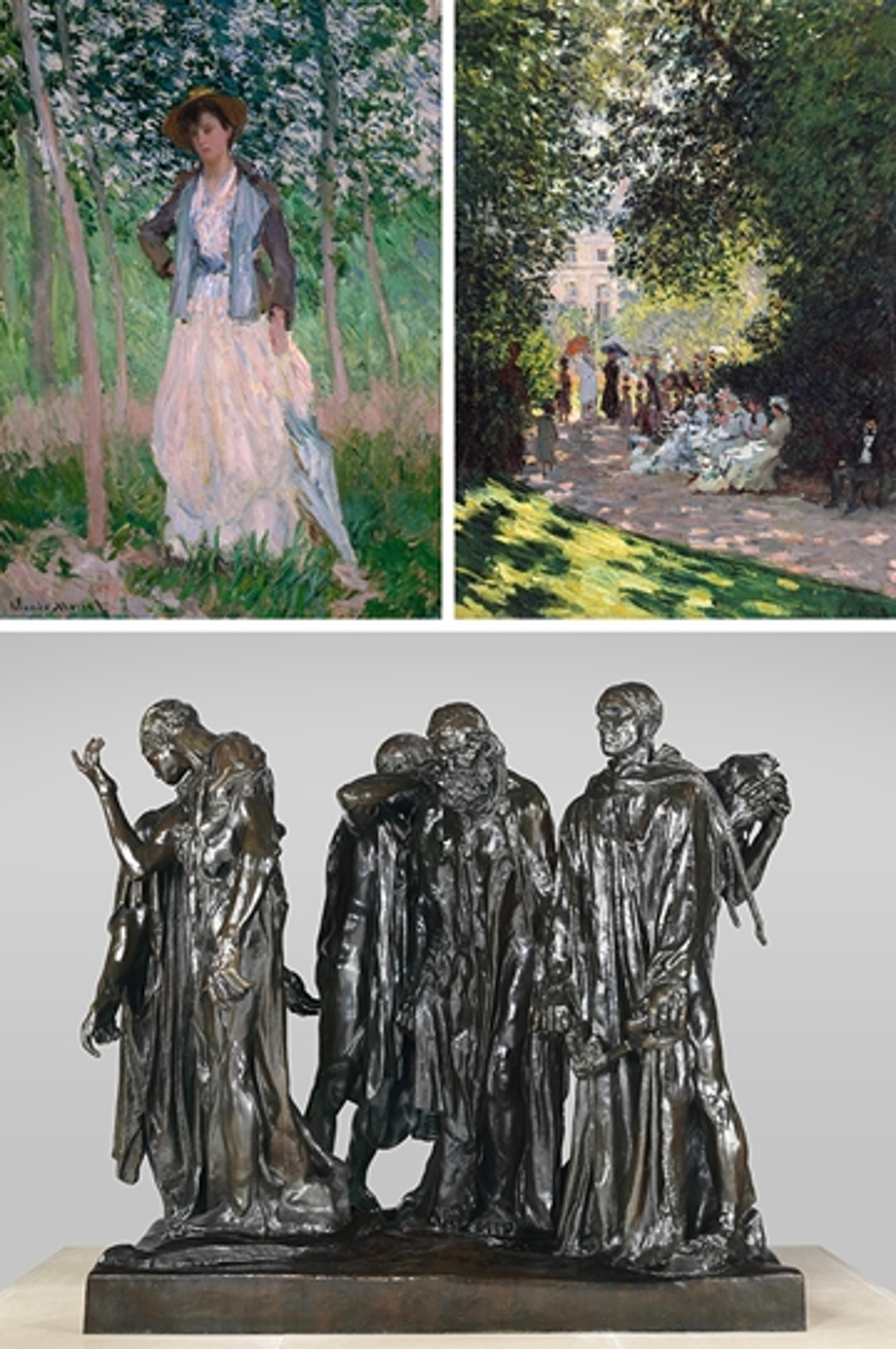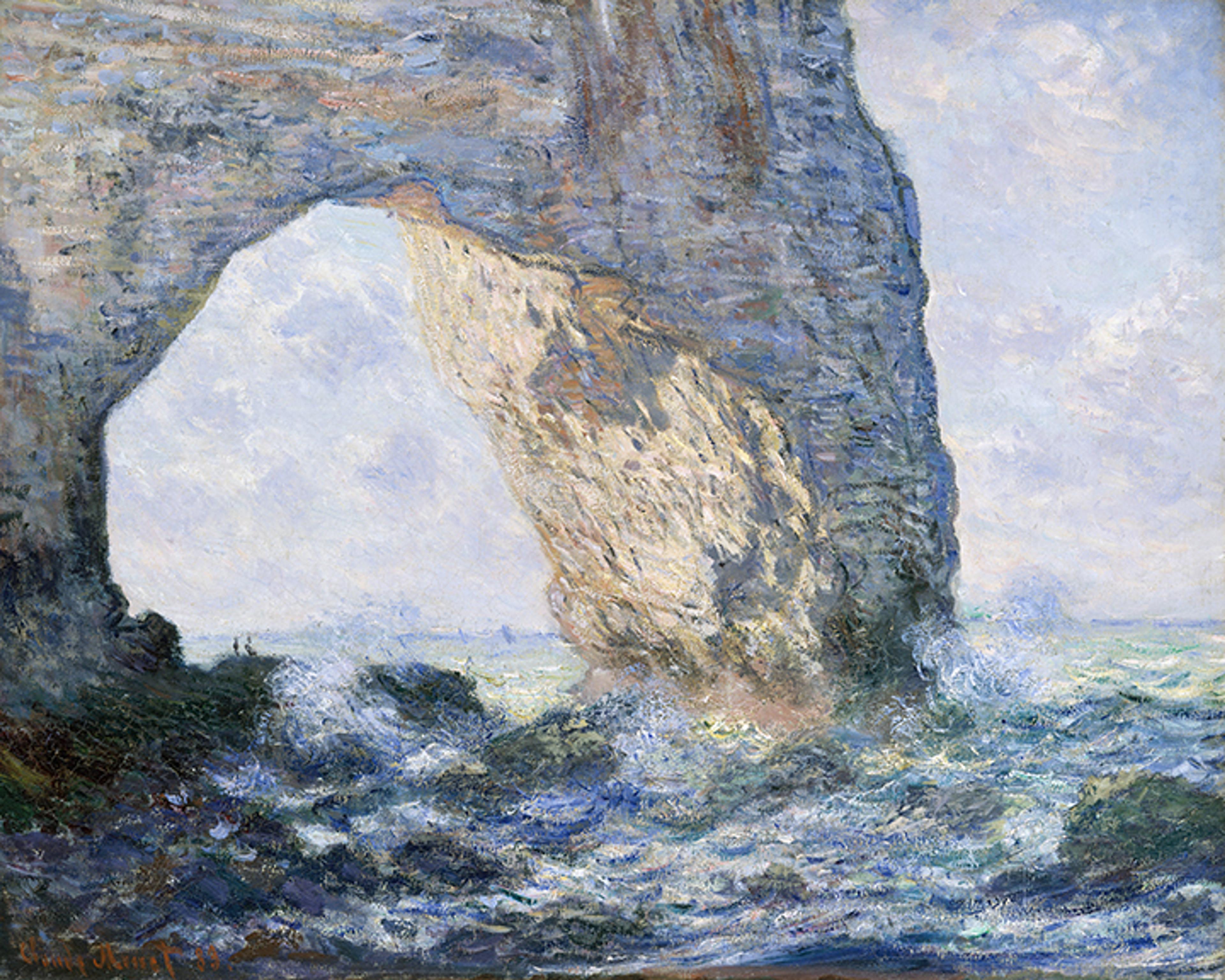Auguste Rodin and Claude Monet: The Pursuit of Nature

Claude Monet (French, 1840–1926). The Seine at Vétheuil, 1880. Oil on canvas, 23 3/4 x 39 1/2 in (60.3 x 100.3 cm). The Metropolitan Museum of Art, New York, Theodore M. Davis Collection, Bequest of Theodore M. Davis, 1915 (30.95.271)
«Claude Monet's The Seine at Vétheuil and Rapids on the Petite Creuse at Fresselines might seem like odd choices to display in Rodin at The Met. Monet was devoted to landscape painting, while Auguste Rodin was dedicated to exploring the expressive potential of the human body. What could they possibly have in common?»

Claude Monet (French, 1840–1926). Rapids on the Petite Creuse at Fresselines, 1889. Oil on canvas, 25 3/4 x 36 1/8 in. (65.4 x 91.8 cm). The Metropolitan Museum of Art, New York, Bequest of Miss Adelaide Milton de Groot (1876–1967), 1967 (67.187.88)
The two artists were more closely related than one might think. They were almost exact contemporaries, born two days apart in November 1840. We think they met in the early 1880s through critics or dealers. After showing together in group exhibitions, Monet pursued a collaboration with Rodin at the high-profile Galerie Georges Petit in Paris in the summer of 1889. Though Rodin agreed, Monet, who was still struggling for acceptance, had the most to gain from this joint endeavor. He mounted a career retrospective of 145 paintings, including, we believe, Rapids on the Petite Creuse at Fresselines and two other pictures now in The Met collection. Rodin, absorbed with newfound success and recent state commissions, could barely be bothered to send 36 sculptures (although he did debut the definitive and complete version, in plaster, of The Burghers of Calais).

Right (clockwise from top left): Claude Monet (French, 1840–1926). The Stroller (Suzanne Hoschedé, later Mrs. Theodore Earl Butler, 1868–1899), 1887. Oil on canvas, 39 5/8 x 27 3/4 in. (100.6 x 70.5 cm). The Metropolitan Museum of Art, New York, The Walter H. and Leonore Annenberg Collection, Bequest of Walter H. Annenberg, 2002 (2003.20.7). Claude Monet (French, 1840–1926). The Parc Monceau, 1878. Oil on canvas, 28 5/8 x 21 3/8 in. (72.7 x 54.3 cm). The Metropolitan Museum of Art, New York, The Mr. and Mrs. Henry Ittleson Jr. Purchase Fund, 1959 (59.142). Auguste Rodin (French, 1840–1917). The Burghers of Calais, modeled 1884–95, cast 1985. Bronze, 82 1/2 x 94 x 95 in. (209.6 x 238.8 x 241.3 cm). The Metropolitan Museum of Art, New York, Gift of Iris and B. Gerald Cantor, 1989 (1989.407)
Unfortunately, though, just before the exhibition opened, Rodin installed some of his work (probably The Burghers of Calais) in front of Monet's paintings. Monet was crushed. He wrote to Georges Petit, "If Rodin had understood that . . . we must work together on the placement . . . it would have been easy to arrive at a good arrangement without hurting each other. . . . I left the gallery completely disheartened."[1] While the incident caused a lot of ill will between the friends, the show was a triumph. Both men were hailed as visionaries.
In 1905, Monet's and Rodin's works were brought together again on this side of the Atlantic in a joint exhibition at the Copley Society in Boston, which was drawn entirely from American collections and the holdings of the dealer Durand-Ruel. It included 11 of Rodin's sculptures and 95 paintings by Monet—his largest exhibition since his show with Rodin in 1889. Among the pictures were The Seine at Vétheuil and several other paintings now owned by The Met.

Claude Monet (French, 1840–1926). The Manneporte (Étretat), 1883. Oil on canvas, 25 3/4 x 32 in. (65.4 x 81.3 cm). The Metropolitan Museum of Art, New York, Bequest of William Church Osborn, 1951 (51.30.5).
In addition to exhibiting together, Monet and Rodin collected each other's work. Rodin acquired, probably as a gift, a painting from Monet's Belle-Île series (now at the Musée Rodin, Paris). Monet owned several works by Rodin: a bronze Young Mother in the Grotto (Musée Marmottan Monet, Paris), a plaster Minotaur (Musée Marmottan Monet, Paris), and a plaster Bacchantes Embracing (private collection). Rodin also gave Monet a drawing titled Salomé(private collection).
Right: Claude Monet (French, 1840–1926). Rouen Cathedral: The Portal (Sunlight), 1894. Oil on canvas, 39 1/4 x 35 7/8 in. (99.7 x 6537 cm). The Metropolitan Museum of Art, New York, Theodore M. Davis Collection, Bequest of Theodore M. Davis, 1915 (30.95.250)

This exchange of artworks points to Monet and Rodin's deep-seated artistic affinities. Despite working in different media and different genres, both sought to capture a sense of immediacy, vitality, and mutability in their art. They handled their materials, whether paint, clay, or plaster, in ways that suggest the artist's hand transmitting a personal response to nature. This often involved innovative effects of light, texture, and lack of finish. For example, Monet's varied brushwork, ranging from quick dabs to long, striated strokes and curlicues of paint, endows his landscapes with a sense of dynamism and change.
Rodin's sculptures, whether in terracotta and plaster that he worked himself, or skillful translations of his original conceptions into marble and bronze, retain a sense of the artist molding, shaping, and carving his medium. These signs of the creative process evoke an intimate physicality and verve unmatched by any other sculptor of the era.

Left: Auguste Rodin (French, 1840–1917). Triton and Nereid, ca. 1886–93. Terracotta, 16 in. (40.6 cm). The Metropolitan Museum of Art, New York, Rogers Fund, 1912 (12.11.2)
The two artists openly admired each other. Rodin wrote to Monet in 1897, "the same feeling of brotherhood, the same love of art, has made us friends forever. . . . I still have the same admiration for the artist who helped me understand light, clouds, the sea, the cathedrals that I already loved so much, but whose beauty awakened at dawn by your interpretation moved me so deeply."[2] Monet wrote in the preface to the catalogue for Rodin's 1900 solo exhibition in Paris, "To truly say what I think [of Rodin] would require a talent that I do not possess: writing is not my métier. But what I want to communicate is my immense admiration for a man unique in his time—great even among the greatest."[3]
Fittingly, Monet's Water Lilies cycle, which he donated to the French state, was originally intended to be placed in a pavilion in the gardens of the Musée Rodin in Paris. Although the Water Lilies were eventually installed in the Musée de l'Orangerie in the Tuileries Gardens, I like to imagine them in proximity to Rodin's The Gates of Hell: two monumental decorative projects by two great modern artists, which encapsulate their respective ambitions. As one critic wrote in 1889, "The one seems to complete the other. Rodin could find no better frame for his sculpture than the painting of Claude Monet. . . . At first glance, one sees that they are a force unto themselves. One is really in their space, and nature is at home here. It is to nature alone that they address their work. . . . Result: surprise, novelty, originality. . . . What they found is life."[4]
Notes
[1] Claude Monet to Georges Petit, June 21, 1889. Location unknown. Quoted in Nadine Lehni, et al., Monet, Rodin: Rien que vous et moi (Paris, 2010), 47–8.
[2] Auguste Rodin to Claude Monet, September 22, 1897. Musée Rodin, Paris. Quoted in Lehni, n.p.
[3] Claude Monet, Exposition Rodin (Paris, 1900), n.p.
[4] Charles Fremine, Le Rappel, June 22, 1889. Quoted in Lehni, 49.
Related Content
Read a blog series on Rodin at Now at The Met.
See more digital content related to Rodin at The Met.
Alison Hokanson
Alison Hokanson is an assistant curator in the Department of European Paintings at The Met.